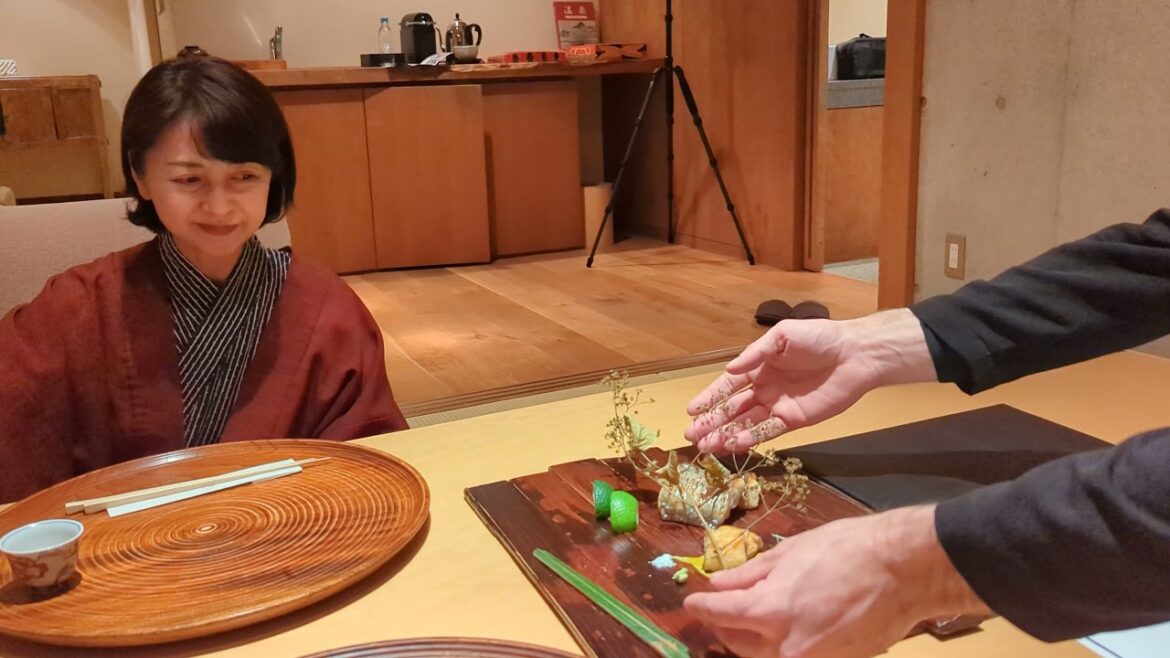We were served dinner in our Kirara (きらら) suite room during our stay at Myoken Ishiharaso (妙見石原荘), a luxury ryokan in Kirishima, Kagoshima (鹿児島県霧島市.) Myoken Ishiharaso is renowned for its food quality, and our meals there did not disappoint. I’ve done my best to summarize each serving in both Japanese and English below. They are:
COURSE 1 – Tokinomono (さきのもの – Seasonal Items):
* Kabu to Kuro Satsuma Dori (蕪と黒さつま鶏 - Japanese Turnip with Satsuma Black Chicken from Kagoshima)
– Yuzu Miso (柚子味噌 – Yuzu Citrus Fruit & Miso Soybean Paste)
– Kabu no Happa (かぶの葉 – Japanese Turnip Leaves)
COURSE 2 – Hatsu Fuyu no Hassun (初冬の八寸 – Beginning of the Winter Seasonal Platter):
* Masu Tamago Oroshi-ae (天降川鱒卵おろしあえ – Salmon Trout Roe from Amori River with Grated Japanese Turnip)
* Komochi Ayu Arima Sansho-ni (子持鮎有馬山椒煮 – Sweetfish with Roe seasoned with Arima Sansho Japanese Pepper)
* Unagi Okowa Sushi (鰻おこわ寿司 – Soy-glazed Grilled Eel with Steamed Glutinous Rice)
* Kagoshima Kinkan Mitsu-ni (鹿児島金柑蜜煮 – Honey-glazed Kagoshima Kumquat)
* Hoshi Gaki Shira-ae (干柿白和え – Dried Persimmons with White Sauce made of mashed Tofu)
* Nagaimo Isobe-age (長芋磯辺揚げ – Chinese Yam / Japanese Mountain Yam Deep-fried and Wrapped with Seaweed)
* Satoimo Tosa-age (里芋土佐揚 – Japanese Taro fried with Bonito Flakes)
COURSE 3 – Kinkai no Sengyo (近海の鮮魚 – “Fresh Fish from the Sea” / Sashimi):
* Hon Maguro (本マグロ – Bluefin Tuna)
* Kurozu Buri (黒酢鰤 – Japanese Amberjack raised in Kagoshima Prefecture with fermented black vinegar as part of their feed)
COURSE 4 – Owan (お椀 – Soup Dish):
* Hakusai Surinagashi (白菜摺り流し – Cabbage Soup)
– Sawara (鰆 – Japanese Spanish Mackerel)
– Shin Kagoshima Takenoko (新鹿児筍 – New Bamboo Shoots from Kagoshima)
– Nanohana (菜の花 – Young Fern of a Rapeseed Plant)
COURSE 5 – Yakimono (焼物 – Grilled Dish):
* Tachiuo Sumibi Shioyaki (太刀魚炭火塩焼 – Salted and Charcoal-grilled Cutlass Fish)
* Kuroge Wagyu Roast with Nama Gobo & Kurozu Tare (黒毛和牛ロース、生牛蒡と黒酢タレ – Kuroge Wagyu from Kagoshima with Burdock Root and Black Vinegar Sauce)
* Unagi Shirayaki (鰻白焼き – Grilled Eel seasoned with salt)
COURSE 6: Gyokai Aburi (魚介炙り – Seared Seafood):
* Kamasu (梭魚 – Barracuda)
* Tsukihigai (月日貝 – Saucer Scallop / Sun & Moon Shell)
* Takaebi (高海老 – Jack-knife Prawns)
– Hayatouri (隼人瓜 – Chayote)
– Kikurage (木耳 – Wood-ear Mushrooms)
– Daikon (大根 – Daikon Radish)
COURSE 7 – Nabemono (鍋物 – Hot Pot):
* Kagoshima Roppaku Kurobuta to Ara/Kue Shiro Miso Shabu (鹿児島六白黒豚とアラ/九絵の白味噌出汁しゃぶ – White Miso Soybean Paste Broth Shabu Shabu with Six-White-Spotted Roppaku Kagoshima Kurobuta Black Pork and Longtooth Grouper)
– Shiitake (椎茸 – Shiitake Mushrooms)
– Negi (葱 – Green Onions)
– Shungiku (春菊 – Crown Daisy)
COURSE 8 – Gohan (御飯 – Rice Dish):
* Shiro Miso Dashi Nabe Zosui (白味噌出汁鍋ぞうすい – Porridge Made in the Hot Pot’s White Miso Soybean Paste Broth with Egg Yolks)
COURSE 9 – Tsukemono (漬物):
* Karami Daikon (辛味大根 – Karami Daikon Radish)
* Takana (高菜 – Japanese Takana Mustard Leaves)
* Konbu (昆布 – Konbu Sea Kelp)
COURSE 10 – Dessert (デザート):
* Kinako Ice Cream Monaka (黄粉アイス最中 – Dried, milled and roasted Sweet Soybean Powder Ice Cream Monaka.) Monaka is a Japanese sweet made two slim fresh wafers produced using mochi and filled with cream inside (usually Azuki Sweet Red Beans but not always)
* Age Soba Mochi (揚げそば餅 – Fried Soba Buckwheat Mochi. Soba mochi is steamed dough made by kneading together buckwheat flour and other ingredients such as young leaves of burdock with wheat flour as a binding agent.)

